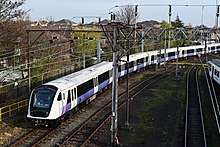Superlink (railway network)
| Superlink | |
|---|---|
 The proposed Superlink railway network | |
| Overview | |
| Type | Commuter rail |
| System | London Rail |
| Status | Cancelled |
| Locale | London, UK |
| Services | 3 (10 branches) |
| Website | Superlink at the Wayback Machine (archived 15 July 2011) |
| Events | |
| Proposed | 2004 |
| Rejected | 2005 |
| Technical | |
| Track gauge | 1,435 mm (4 ft 8 1⁄2 in) standard gauge |
Superlink was a proposal for a new UK railway network to connect London, the south-east Midlands, East Anglia, and south-east England.
First proposed in 2004 by a group of senior railway managers who played leading roles in other UK rail projects, Superlink was put forward as an alternative system to the Crossrail scheme then being planned. The proponents of Superlink claimed that the benefits of Crossrail — including relief of congestion on London's public transport network — had been overstated, and argued that it would give poor value for money.[1][2]
Superlink was rejected by planners in 2005. Crossrail received Royal Assent in 2007 and a funding agreement in 2008.
2005 report
In a 2005 report, CLRL examined the proposal and rejected it on the following grounds:[3]
- The large number of branches and long distances would not be compatible with short and regular train intervals through the central tunnel, leading to performance problems and transmission of delay between parts of the network.
- Although increased demand for commuting into London is predicted in the regions served, these are already planned to be catered for with less costly train lengthening. Also, development and planning policy in these regions seeks to achieve sustainable growth and local employment, with less reliance on long distance commuting.
- CLRL found the cost estimates of Superlink to be unreliable, eroding a key claim that it would be easier to finance than Crossrail. The estimated construction cost is 55% greater.
- Superlink would require construction of new track and possibly a depot and stations in the green belt between Barkingside, Shenfield and Harlow. This causes environmental and planning issues.
Superlink Response

Superlink responded in detail to each of the criticisms.
- It pointed out that the Thameslink scheme, currently being developed, would have many more branches than Superlink. Moreover, all Superlink connections to existing rail lines have been designed to allow isolation of delays on any branch, so as not to impact the rest of the network.
- It argued that Crossrail had greatly overstated the costs of its proposals, and that Superlink would offer faster and more reliable services, as well as the additional capacity that can be provided by train lengthening. While Superlink accepted that the capital costs would be about £3 billion higher, it would attract additional revenues that could fund £6 billion or more of investment, actually reducing the net cost to the taxpayer.
- Superlink suggested that many other road and rail schemes, including the new HS2 high speed railway, have required construction in the Greenbelt, implying the impacts can be mitigated to an acceptable level.
- While Superlink sympathised with the objective of reducing reliance on long-distance commuting, it argued that growth is inevitable and at least Superlink will help more of it go by rail and less by road. Superlink also published a detailed critique of the Crossrail, suggesting that benefits have been significantly over-stated.
In any case, the Crossrail scheme seems to have been modified in line with some of Superlink's suggestions. Plans for a depot at Romford in east London have been abandoned, with Crossrail now planning to utilise the depot at North Pole in west London, recently vacated by Eurostar. Plans for a branch to Kingston and Richmond were dropped. In its 2011 Route utilisation strategy for London and the southeast, Network Rail put forward Superlink's proposal that Crossrail take over the Northampton line trains with a new connection at Old Oak Common. This would complement proposals for a new interchange station between Crossrail and the proposed High Speed 2 line at this location.
See also
References
- ↑ "Rival cross-city rail plan aired". BBC News. 15 December 2004. Archived from the original on 29 May 2018. Retrieved 29 May 2018.
- ↑ "Superlink - a Crossrail that can Happen" (PDF). Superlink. April 2005. Archived from the original (PDF) on 15 July 2011. Retrieved 29 May 2018.
- ↑ Landels, John (24 May 2005). "SuperCrossrail and Superlink Update Report" (PDF). Cross London Rail Links Limited. Archived from the original (PDF) on 18 October 2007. Retrieved 13 September 2018.